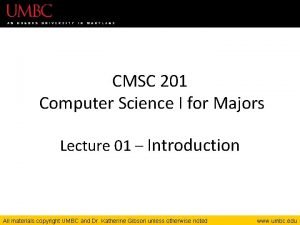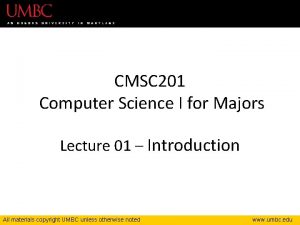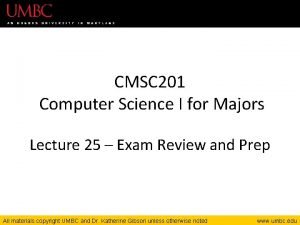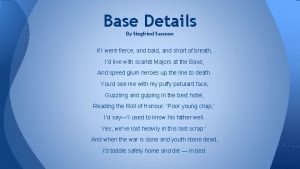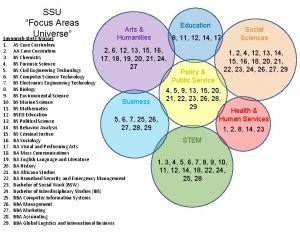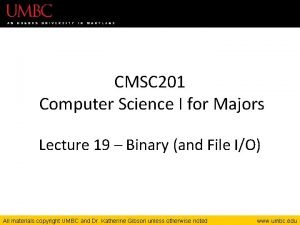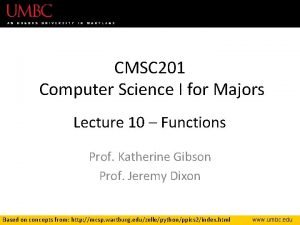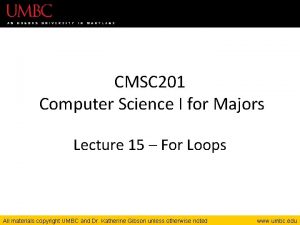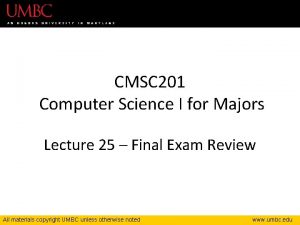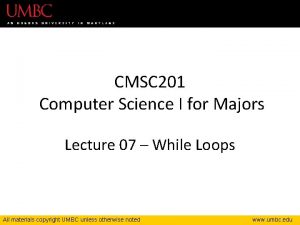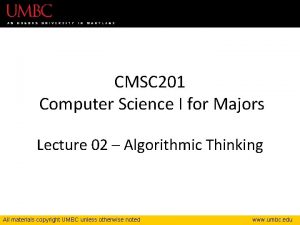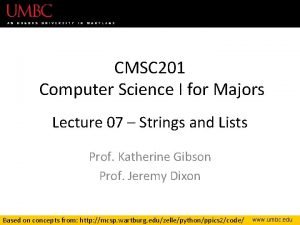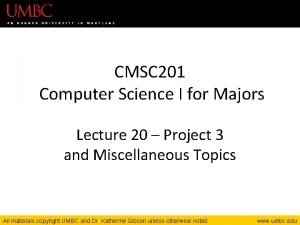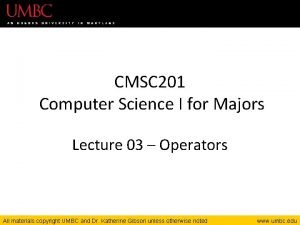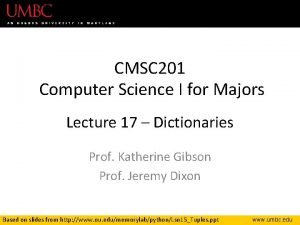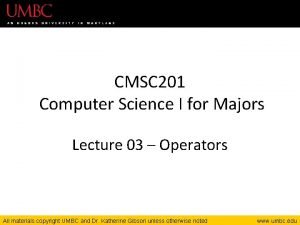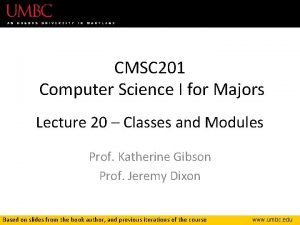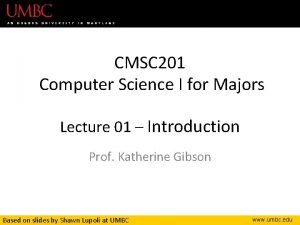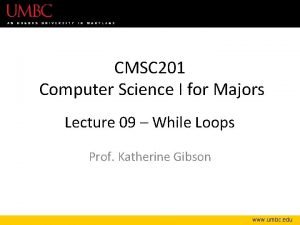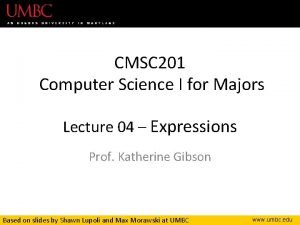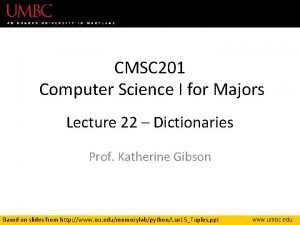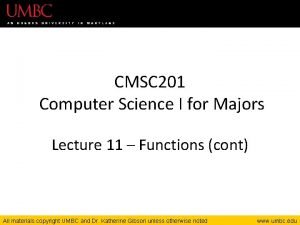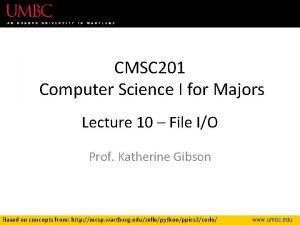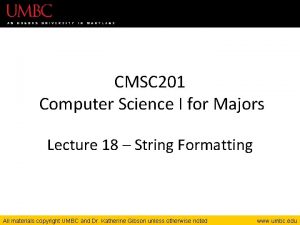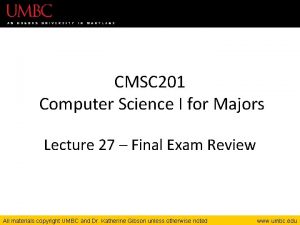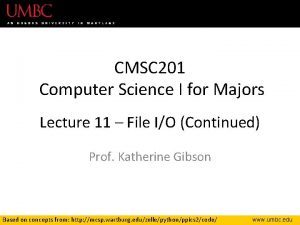CMSC 201 Computer Science I for Majors Lecture








































- Slides: 40

CMSC 201 Computer Science I for Majors Lecture 03 – Variables Prof. Katherine Gibson Based on slides by Shawn Lupoli and Max Morawski at UMBC www. umbc. edu

Last Class We Covered • Algorithms • Program Development • Control Structures – Sequential – Decision Making – Loops • Types of Errors – Syntax – Logic 2 www. umbc. edu

Any Questions from Last Time? www. umbc. edu

Today’s Objectives • To start learning Python • To learn more about variables – How to use them – Different types • To learn how to use input and output – To do interesting things with our program • To play a party game 4 www. umbc. edu

“Cowboy Coding” • Jumping right in to writing code • Disadvantages – No formal management of project – No standard way of coding – Not planning things out • Forgetting to include important things • Having to make big changes later 5 www. umbc. edu

Software Development Process 1. Analyze the problem – Determine specifications (requirements) 2. Create a design 3. Implement the design 4. Test and debug the program 5. Maintain the program 6 www. umbc. edu

Example: Temperature Converter You have been invited to live in Europe during a semester abroad. You aren’t sure how to dress because the temperature is given in Celsius. • Problem: – Temperature is given in Celsius • Solution: – Write a program to convert Celsius to Fahrenheit 7 www. umbc. edu

Input/Process/Output • Input – What information do you need for your converter? • Process – What formulas do you need for your converter? • Output – What is the output from your converter? 8 www. umbc. edu

Introduction to Python (Variables) www. umbc. edu

Python • Python is a widely used language – General purpose – High-level language • Emphasizes code readability – More streamlined than some other languages 10 www. umbc. edu

“Hello World!” • In Python: print(“Hello World!”) • In the C++ programming language: #include <iostream> int main() { std: : cout << "Hello, world!n"; } 11 www. umbc. edu

Elements of a Program • Identifiers – Variables – Modules (later in the semester) – Functions (later in the semester) • Expressions – Code that manipulates or evaluates identifiers 12 www. umbc. edu

We Start Python Today! • Two ways to use python We will write programs – You can write a program as a series of instructions in a file and then execute it – You can also test simple Python commands in the Python interpreter. 13 www. umbc. edu

Rules for Naming Variables • Variables can contain: – Uppercase letters (A-Z) – Lowercase letters (a-z) – Numbers (0 -9) – Underscores (_) • Variables can’t contain: – Special characters ($, #, &, ^, ), (, @) 14 www. umbc. edu

More Rules for Naming Variables • Variables can be any length –x – Is. Kanye. Running. For. President. In 2020 – my. Name • Variables cannot start with a digit – 2 cool 4 school is not a valid variable – cool 4 school is a valid variable 15 www. umbc. edu

Variables and Keywords • Keywords are the reserved words in Python • Variables cannot be keywords – or is not a valid variable name – orange is an acceptable variable name 16 www. umbc. edu

What Is a Variable? • Something that holds a value – Can change (multiple times) • Similar to variables in math • In simple terms, a variable is a “box” that you can put stuff in 17 www. umbc. edu

Exercise: Variables • Are the following legal or illegal in Python? 18 1 spam No – Illegal! raise 1 Yes – legal! Spam_And_Eggs Yes – legal! www. umbc. edu

Using Variables in Python • Create a variable by declaring it • Also need to initialize it – Use the assignment operator (=) assignment operator rich. Fiddy = 50000000 poor. Fiddy = 0. 50 broke. Fiddy = 0 19 www. umbc. edu

Introduction to Python (Expressions) www. umbc. edu

Expressions • Programs manipulate data – Allows us to do interesting things • Expressions calculate new data values • Use assignment operator to set new value 21 www. umbc. edu

Expressions Example variable being set assignment operator num. Candy = 10 value price. Candy = 0. 50 total. Candy = num. Candy * price. Candy expression 22 www. umbc. edu

Common Mistake • Many new programmers mix up the left and right hand sides of the assignment operator • Variable being set is on the left • Expression is on the right num. Candy = 10 10 = num. Candy 23 www. umbc. edu

Variable Types • There are many different kinds of variables! – Numbers • Integers • Decimals – Booleans (True and False) – Strings (collections of characters) 24 www. umbc. edu

Variables Types: Examples a. String decimal_1 my. Bool whole. Num = = "Hello class" 1. 12 True 7 dog. Name = “Mrs. Wuffington“ class. Code = 201 25 www. umbc. edu

Variable Usage • Variables are designed for storing information • Any piece of information your program uses or records must be stored in a variable 26 www. umbc. edu

Introduction to Python (Input and Output) www. umbc. edu

Output • Output is text printed to the screen – So the user can see it and respond • One command for this is print 28 www. umbc. edu

Output Example print (3+4) print (3, 4, 3+4) print("The answer is", 3+4) 7 3 4 7 The answer is 7 29 www. umbc. edu

Output Exercise 1 • What will the following code snippet print? a = 10 b = a * 5 c = "Your result is: " print(c, b) Your result is: 30 50 www. umbc. edu

Output Exercise 2 • What will the following code snippet print? a = 10 b = a There are two possible a = 3 options for what this print(b) could do! Any guesses? 10 31 www. umbc. edu

Output Exercise 2 Explanation • Why does it print out 10? • When you set one variable equal to another, they don’t become linked! • After b is set to 10, it no longer has anything else to do with a 32 www. umbc. edu

Input • Input is text we get from the user. Num = input("Please enter a number: ") print(user. Num) • The output will look like this: Please enter a number: 10 10 33 www. umbc. edu

How Input Works user. Num = input("Please enter a number: ") • Takes the text the user entered and stores it – In the variable named user. Num • You can do this as many times as you like! user. Num = input(“Enter another number: ") user. Num 2 = input(“Enter a new number: ") user. Age = input(“Please enter your age: ") 34 www. umbc. edu

Input as a String • Everything that comes through input() will come in the form of a string • There is a difference between "10" and 10 – "10" is a two character long string – 10 is understood by Python as a number 35 www. umbc. edu

Converting from String • To turn an input string into a number, you can do the following: a. Num = input("Enter a number: ") a. Num = int(a. Num) • int stands for integer (a whole number) 36 www. umbc. edu

Class Exercise: Mad Libs • Mad Libs is a phrasal template word game where one player prompts others for a list of words to substitute for blanks in a story, before reading the – often comical or nonsensical – story aloud. • The game is frequently played as a party game or as a pastime 37 www. umbc. edu

Exercise: Calculating Averages • Write, on paper or on your computer, a program that asks the user for two numbers and prints out the average. • Make sure to use variables, and to get the input from the user! 38 www. umbc. edu

Exercise: Assignment Weighting • Pretend you’re writing a program to compute someone’s weight grade. You have so far: hw. Weight = 0. 4 exam. Weight = 0. 5 discussion. Weight = 0. 1 • Write a program that then asks the user for their homework grade, exam grade, and discussion grade and prints out their total grade in the class. 39 www. umbc. edu

Announcements • Your Lab 1 is an online lab this week! – Due by this Thursday (Sept 3 rd) at 8: 59 PM • Homework 1 is out – Due by next Tuesday (Sept 8 th) at 8: 59 PM • Both of these assignments are on Blackboard – Weekly Agendas are also on Blackboard 40 www. umbc. edu
 Cmsc 201 umbc
Cmsc 201 umbc Cmsc 201
Cmsc 201 Cmsc 201 umbc
Cmsc 201 umbc 01:640:244 lecture notes - lecture 15: plat, idah, farad
01:640:244 lecture notes - lecture 15: plat, idah, farad Test for english majors-band 4
Test for english majors-band 4 Base details
Base details Gju majors
Gju majors Savannah state university majors
Savannah state university majors Uwlax majors
Uwlax majors Texas state university psychology department
Texas state university psychology department Uwb majors
Uwb majors Ung dual enrollment requirements
Ung dual enrollment requirements Websmart smccd canvas
Websmart smccd canvas Wku majors
Wku majors Umn majors
Umn majors Math is my favourite subject
Math is my favourite subject Physical science lecture notes
Physical science lecture notes Computer security 161 cryptocurrency lecture
Computer security 161 cryptocurrency lecture Computer aided drug design lecture notes
Computer aided drug design lecture notes Computer architecture notes
Computer architecture notes Isa vs microarchitecture
Isa vs microarchitecture Fspos vägledning för kontinuitetshantering
Fspos vägledning för kontinuitetshantering Novell typiska drag
Novell typiska drag Nationell inriktning för artificiell intelligens
Nationell inriktning för artificiell intelligens Ekologiskt fotavtryck
Ekologiskt fotavtryck Varför kallas perioden 1918-1939 för mellankrigstiden?
Varför kallas perioden 1918-1939 för mellankrigstiden? En lathund för arbete med kontinuitetshantering
En lathund för arbete med kontinuitetshantering Särskild löneskatt för pensionskostnader
Särskild löneskatt för pensionskostnader Tidböcker
Tidböcker Anatomi organ reproduksi
Anatomi organ reproduksi Vad är densitet
Vad är densitet Datorkunskap för nybörjare
Datorkunskap för nybörjare Tack för att ni lyssnade bild
Tack för att ni lyssnade bild Att skriva en debattartikel
Att skriva en debattartikel Autokratiskt ledarskap
Autokratiskt ledarskap Nyckelkompetenser för livslångt lärande
Nyckelkompetenser för livslångt lärande Påbyggnader för flakfordon
Påbyggnader för flakfordon Formel för lufttryck
Formel för lufttryck Svenskt ramverk för digital samverkan
Svenskt ramverk för digital samverkan I gullregnens månad
I gullregnens månad Presentera för publik crossboss
Presentera för publik crossboss
